AMD Dives Deep On High Bandwidth Memory - What Will HBM Bring AMD?
by Ryan Smith on May 19, 2015 8:40 AM ESTThe Net Benefits of HBM
Now that we’ve had a chance to talk about how HBM is constructed and the technical hurdles in building it, we can finally get to the subject of the performance and design benefits of HBM. HBM is of course first and foremost about further increasing memory bandwidth, but the combination of stacked DRAM and lower power consumption also opens up some additional possibilities that could not be pursued with GDDR5.
We’ll start with the bandwidth capabilities of HBM. The amount of bandwidth ultimately depends on the number of stacks in use along with the clockspeed of those stacks. HBM uses a DDR signaling interface, and while AMD is not disclosing final product specifications at this time, they have given us enough information to begin to build a complete picture.
| GPU Memory Math | |||||
| AMD Radeon R9 290X | NVIDIA GeForce GTX Titan X | Theoretical 4-Stack HBM1 | |||
| Total Capacity | 4GB | 12GB | 4GB | ||
| Bandwidth Per Pin | 5Gbps | 7Gbps | 1Gbps | ||
| Number of Chips/Stacks | 16 | 24 | 4 | ||
| Bandwidth Per Chip/Stack | 20GB/sec | 14GB/sec | 128GB/sec | ||
| Effective Bus Width | 512-bit | 384-bit | 4096-bit | ||
| Total Bandwidth | 320GB/sec | 336GB/sec | 512GB/sec | ||
| Estimated DRAM Power Consumption |
30W | 31.5W | 14.6W | ||
The first generation of HBM AMD is using allows for each stack to be clocked up to 500MHz, which after DDR signaling leads to 1Gbps per pin. For a 1024-bit stack this means a single stack can deliver up to 128GB/sec (1024b * 1G / 8b) of memory bandwidth. HBM in turn allows from 2 to 8 stacks to be used, with each stack carrying 1GB of DRAM. AMD’s example diagrams so far (along with NVIDIA’s Pascal test vehicle) have all been drawn with 4 stacks, in which case we’d be looking at 512GB/sec of memory bandwidth. This of course is quite a bit more than the 320GB/sec of memory bandwidth for the R9 290X or 336GB/sec for NVIDIA’s GTX titan X, working out to a 52-60% increase in memory bandwidth.
At the same time this also calls into question memory capacity – 4 1GB stacks is only 4GB of VRAM – though AMD seems to be saving that matter for the final product introduction later this quarter. Launching a new, high-end GPU with 4GB could be a big problem for AMD, but we'll see just what they have up their sleeves in due time.
What’s perhaps more interesting is what happens to DRAM energy consumption with HBM. As we mentioned before, R9 290X spends 15-20% of its 250W power budget on DRAM, or roughly 38-50W of power on an absolute basis. Meanwhile by AMD’s own reckoning, GDDR5 is good for 10.66GB/sec of bandwidth per watt of power, which works out to 30W+ via that calculation. HBM on the other hand delivers better than 35GB/sec of bandwidth per watt, an immediate 3x gain in energy efficiency per watt.
Of course AMD is then investing some of those gains back in to coming up with more memory bandwidth, so it’s not as simple as saying that memory power consumption has been cut by 70%. Rather given our earlier bandwidth estimate of 512GB/sec of memory bandwidth for a 4 stack configuration, we would be looking at about 15W of power consumption for a 512GB/sec HBM solution, versus 30W+ for a 320GB/sec GDDR5 solution. The end result then points to DRAM power consumption being closer to halved, with AMD saving 15-20W of power.
What’s the real-world advantage of a 15-20W reduction in DRAM power consumption? Besides being able to invest that in reducing overall video card power consumption, the other option is to invest it in increasing clockspeeds. With PowerTune putting a hard limit on power consumption, a larger GPU power budget would allow AMD to increase clockspeeds and/or run at the maximum GPU clockspeed more often, improving performance by a currently indeterminable amount. Now as fair warning here, higher GPU clockspeeds typically require higher voltages, which in turn leads to a rapid increase in GPU power consumption. So although having additional power headroom does help the GPU, it may not be good for quite as much of a clockspeed increase as one might hope.
Meanwhile the performance increase from the additional memory bandwidth is equally nebulous until AMD’s new product is announced and benchmarked. As a rule of thumb GPUs are virtually always memory bandwidth bottlenecked – they are after all high-throughput processors capable of trillions of calculations per second working with only hundreds of billions of bytes of bandwidth – so there is no doubt that the higher memory bandwidths of HBM will improve performance. However memory bandwidth increases currently don’t lead to 1:1 performance increases even on AMD’s current cards, and it’s unlikely to be any different on future products.
Throwing an extra wrinkle into matters, any new AMD product would be based on GCN 1.2 or newer, which introduced AMD’s latest generation of color compression technology. The net result is that on identical workloads, memory bandwidth pressure is going down exactly at the same time as memory bandwidth availability is going up. AMD will end up gaining a ton of effective memory bandwidth – something that will be very handy for high resolutions – but it also makes it impossible to predict what the final performance impact might be. Still, it will be interesting to see what AMD can do with a 2x+ increase in effective memory bandwidth for graphics workloads.
The final major benefit AMD is looking at taking advantage of with HBM – and that this point they’re not even being subtle about – is new form factor designs from the denser designs enabled by HBM. With the large GDDR5 memory chips replaced with much narrower HBM stacks, AMD is telling us that the resulting ASIC + RAM setups can be much smaller.
How much smaller? Well 1GB of GDDR5, composed of 2Gbit modules (the standard module size for R9 290X) would take up 672mm2, versus just 35mm2 for the same 1GB of DRAM as an HBM stack. Even if we refactor this calculation for 4Gbit modules – the largest modules used in currently shipping video cards – then we still end up with 336mm2 versus 35mm2, which is still a savings of 89% for 1GB of DRAM. Ultimately the HBM stack itself is composed of multiple DRAM dies, so there’s still quite a bit of silicon in play, however its 2D footprint is reduced significantly thanks to stacking.
By AMD’s own estimate, a single HBM-equipped GPU package would be less than 70mm X 70mm (4900mm2), versus 110mm X 90mm (9900mm2) for R9 290X. Throw in additional space savings from the fact that HBM stacks don’t require quite as complex power delivery circuitry, and the card space savings could be significant. By our reckoning the total card size will still be fairly big – all of those VRMs and connectors need to go somewhere – but there is potential for significant savings. What AMD intends to do with those savings remains to be seen, but with apologies to AMD on this one, NVIDIA has already shown off their Pascal test vehicle for their mezzanine connector design, and it goes without saying that such a form factor opens up some very interesting possibilities.
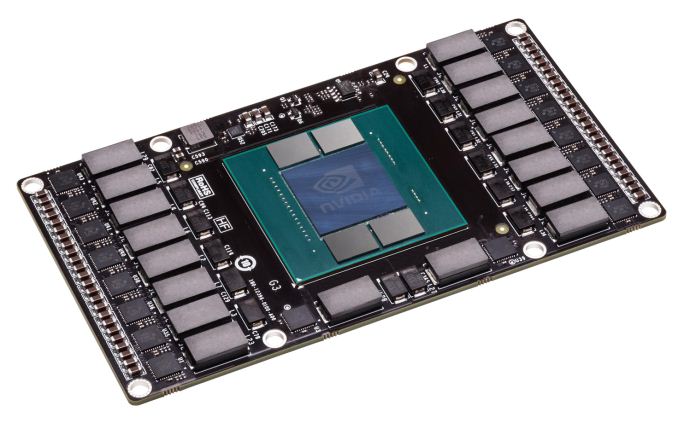
With apologies to AMD: NVIDIA’s Pascal Test Vehicle, An Example Of A Smaller, Non-Traditional Video Card Design
Finally, aftermarket enthusiasts may or may not enjoy one final benefit from the use of HBM. Because the DRAM and GPU are now on the same package, AMD is going to be capping the package with an integrated heat spreader (IHS) to compensate for any differences in height between the HBM stacks and GPU die, to protect the HBM stacks, and to supply the HBM stacks with sufficient cooling. High-end GPU dies have been bare for some time now, so an IHS brings with it the same kind of protection for the die that IHSs brought to CPUs. At the same time however this means it’s no longer possible to make direct contact with the GPU, so extreme overclockers may come away disappointed. We’ll have to see what the shipping products are like and whether in those cases it’s viable to remove the IHS.
Closing Thoughts
Bringing this deep dive to a close, as the first GPU manufacturer to be shipping an HBM solution – in fact AMD expects to be the only vendor to ship an HBM1 solution – AMD has set into motion some very aggressive product goals thanks to the gains from HBM. Until we know more about AMD’s forthcoming video card I find it prudent to keep expectations in check here, as HBM is just one piece of the complete puzzle that is a GPU. But at the same time let’s be clear here: HBM is the future memory technology of GPUs, there is potential for significant performance increases thanks to the massive increase in memory bandwidth offers, and for roughly the next year AMD is going to be the only GPU vendor offering this technology.
AMD for their part is looking to take as much of an advantage of their lead as they can, both at the technical level and the consumer level. At the technical level AMD has said very little about performance so far, so we’ll have to wait and see just what their new product brings. But AMD is being far more open about their plans to exploit the size advantage of HBM, so we should expect to see some non-traditional designs for high-end GPUs. Meanwhile at the consumer level, expect to see HBM enter the technology lexicon as the latest buzzword for high-performance products – almost certainly to be stamped on video card boxes today just as GDDR5 has been for years – as AMD looks to let everyone know about their advantage.
Meanwhile shifting gears towards the long term, high-end GPUs are just the first of what AMD expects to be a wider rollout for HBM. Though AMD is not committing to any other products at this time, as production ramps up and costs come down, HBM is expected to become financially viable in a wider range, including lower-end GPUs, HPC products (e.g. FirePro S and AMD’s forthcoming HPC APU), high-end communications gear, and of course AMD’s mainstream consumer APUs. As lower-margin products consumer APUs will likely be among the farthest off, however in the long-run they may very well be the most interesting use case for HBM, as APUs are among the most bandwidth-starved graphics products out there. But before we get too far ahead of ourselves, let’s see what AMD is able to do with HBM on their high-end video cards later this quarter.


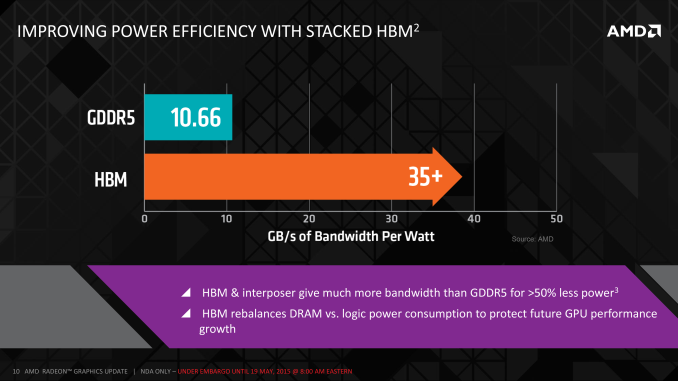
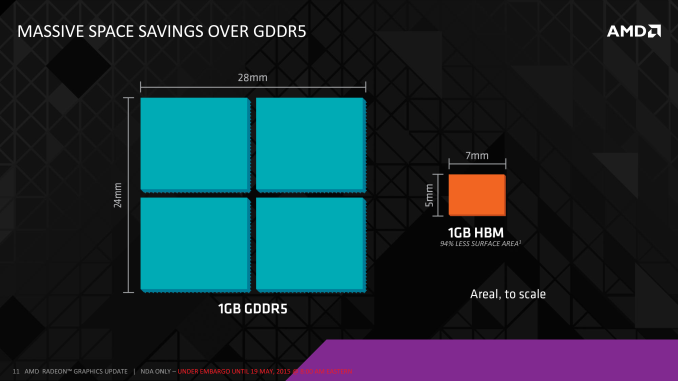
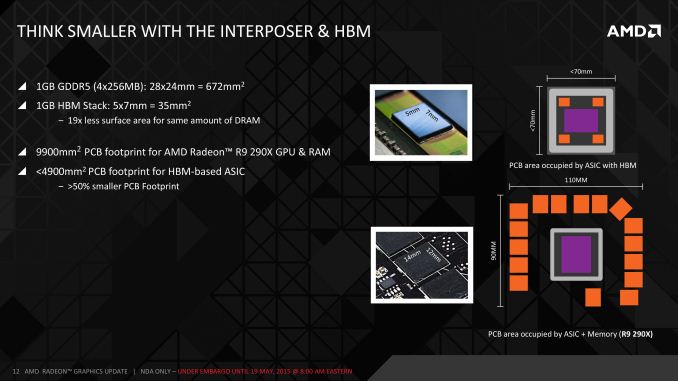
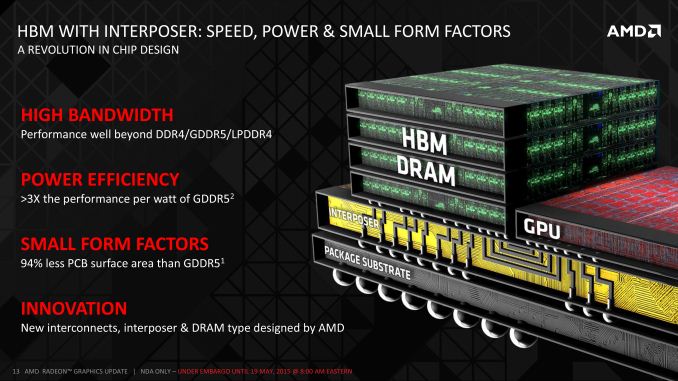








163 Comments
View All Comments
phoenix_rizzen - Wednesday, May 20, 2015 - link
I see you missed the part of the article that discusses how the entire package, RAM and GPU cores, will be covered by a heat spreader (most likely along with some heat transferring goo underneath to make everything level) that will make it easier to dissipate heat from all the chips together.Similar to how Intel CPU packages (where there's multiple chips) used heat spreaders in the past.
vortmax2 - Wednesday, May 20, 2015 - link
Is this something that AMD will be able to license? Wondering if this could be a potential significant revenue stream for AMD.Michael Bay - Wednesday, May 20, 2015 - link
So what`s the best course of action?Wait for the second generation of technology?
wnordyke - Wednesday, May 20, 2015 - link
You will wait 1 year for the second generation. The second generation chips will be a big improvement over the current chips. (Pascal = 8 X Maxwell). (R400 = 4 X R390)Michael Bay - Wednesday, May 20, 2015 - link
4 times Maxwell seems nice.I`m in no hurry to upgrade.
akamateau - Thursday, May 28, 2015 - link
No not at all.HBM doesn't need the depth of memory that DDR4 or DDR5 does. DX12 performance is going to go through the roof.
HBM was designed to solve the GPU bottleneck. The electrical path latecy improvement is at least one clock not to mention the width of the pipes. The latency improvement will likely be 50% better. In and out. HBM will outperform ANYTHING that nVidia has out using DX12.
Use DX11 and you cripple your GPU anyway. You can only get 10% of the DX12 performance out of your system.
So get Windows 10 enable DX12 and buy this Card; by Christmas ALL games will be out DX12 capable as Microsoft is supporting DX12 with XBOX.
Mat3 - Thursday, May 21, 2015 - link
What if you put the memory controllers and the ROPs on the memory stack's base layer? You'd save more area for the GPU and have less data traffic going from the memory to the GPU.akamateau - Thursday, May 28, 2015 - link
That is what the interposer is for.akamateau - Monday, June 8, 2015 - link
AMD is already doing that. Here is their Patent.Interposer having embedded memory controller circuitry
US 20140089609 A1
" For high-performance computing systems, it is desirable for the processor and memory modules to be located within close proximity for faster communication (high bandwidth). Packaging chips in closer proximity not only improves performance, but can also reduce the energy expended when communicating between the processor and memory. It would be desirable to utilize the large amount of "empty" silicon that is available in an interposer. "
And a little light reading:
“NoC Architectures for Silicon Interposer Systems Why pay for more wires when you can get them (from your interposer) for free?” Natalie Enright Jerger, Ajaykumar Kannan, Zimo Li Edward S. Rogers Department of Electrical and Computer Engineering University of Toronto Gabriel H. Loh AMD Research Advanced Micro Devices, Inc”
http://www.eecg.toronto.edu/~enright/micro14-inter...
TheJian - Friday, May 22, 2015 - link
It's only an advantage if you're product actually WINS the gaming benchmarks. Until then, there is NO advantage. And I'm not talking winning benchmarks that are purely used to show bandwidth (like 4k when running single digits fps etc), when games are still well below 30fps min anyway. That is USELESS. IF the game isn't playable at whatever settings your benchmarking that is NOT a victory. It's like saying something akin to this "well if we magically had a gpu today that COULD run 30fps at this massively stupid resolution for today's cards, company X would win"...LOL. You need to win at resolutions 95% of us are using and in games we are playing (based on sales hopefully in most cases).Nvidia's response to anything good that comes of rev1 HBM will be, we have more memory (perception after years of built up more mem=better), and adding up to 512bit bus (from current 384 on their cards) if memory bandwidth is any kind of issue for next gen top cards. Yields are great on GDDR5, speeds can go up as shrinks occur and as noted Nvidia is on 384bit leaving a lot of room for even more memory bandwidth if desired. AMD should have went one more rev (at least) on GDDR5 to be cost competitive as more memory bandwidth (when GCN 1.2+ brings more bandwidth anyway) won't gain enough to make a difference vs. price increase it will cause. They already have zero pricing power on apu, cpu and gpu. This will make it worse for a brand new gpu.
What they needed to do was chop off compute crap that most don't use (saving die size or committing that size to more stuff we DO use in games), and improve drivers. Their last drivers were december 2014 (for apu or gpu, I know, I'm running them!). Latest beta on their site is 4/12. Are they so broke they can’t even afford a new WHQL driver every 6 months?
No day 1 drivers for witcher3. Instead we get complaints that gameworks hair cheats AMD and complaints CDPR rejected tressfx two months ago. Ummm, should have asked for that the day you saw witcher3 wolves with gameworks hair 2yrs ago, not 8 weeks before game launch. Nvidia spent 2yrs working with them on getting the hair right (and it only works great on the latest cards, screws kepler too until possible driver fixes even for those), while AMD made the call to CDPR 2 months ago...LOL. How did they think that call would go this late into development which is basically just spit and polish in the last months? Hairworks in this game is clearly optimized for maxwell at the moment but should improve over time for others. Turn down the aliasing on the hair if you really want a temp fix (edit the config file). I think the game was kind of unfinished at release TBH. There are lots of issues looking around (not just hairworks). Either way, AMD clearly needs to do the WORK necessary to keep up, instead of complaining about the other guy.